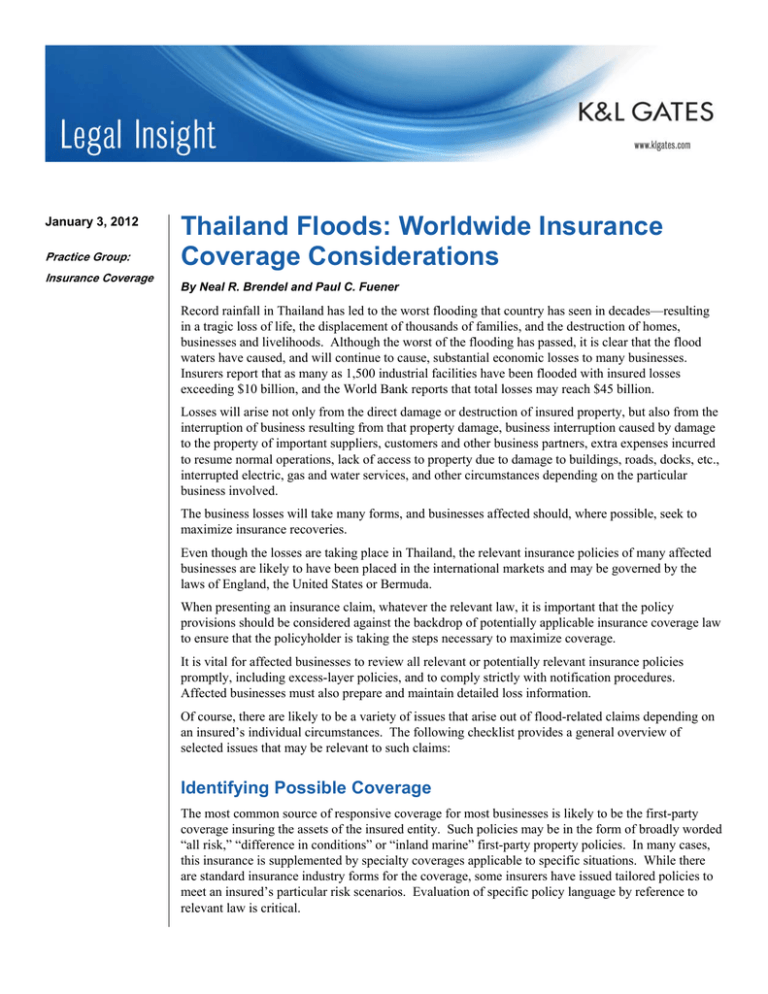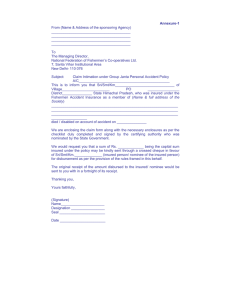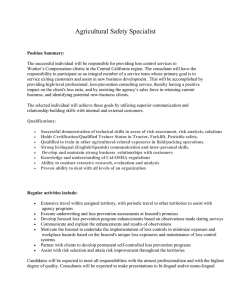Thailand Floods: Worldwide Insurance Coverage Considerations
advertisement

January 3, 2012 Practice Group: Insurance Coverage Thailand Floods: Worldwide Insurance Coverage Considerations By Neal R. Brendel and Paul C. Fuener Record rainfall in Thailand has led to the worst flooding that country has seen in decades—resulting in a tragic loss of life, the displacement of thousands of families, and the destruction of homes, businesses and livelihoods. Although the worst of the flooding has passed, it is clear that the flood waters have caused, and will continue to cause, substantial economic losses to many businesses. Insurers report that as many as 1,500 industrial facilities have been flooded with insured losses exceeding $10 billion, and the World Bank reports that total losses may reach $45 billion. Losses will arise not only from the direct damage or destruction of insured property, but also from the interruption of business resulting from that property damage, business interruption caused by damage to the property of important suppliers, customers and other business partners, extra expenses incurred to resume normal operations, lack of access to property due to damage to buildings, roads, docks, etc., interrupted electric, gas and water services, and other circumstances depending on the particular business involved. The business losses will take many forms, and businesses affected should, where possible, seek to maximize insurance recoveries. Even though the losses are taking place in Thailand, the relevant insurance policies of many affected businesses are likely to have been placed in the international markets and may be governed by the laws of England, the United States or Bermuda. When presenting an insurance claim, whatever the relevant law, it is important that the policy provisions should be considered against the backdrop of potentially applicable insurance coverage law to ensure that the policyholder is taking the steps necessary to maximize coverage. It is vital for affected businesses to review all relevant or potentially relevant insurance policies promptly, including excess-layer policies, and to comply strictly with notification procedures. Affected businesses must also prepare and maintain detailed loss information. Of course, there are likely to be a variety of issues that arise out of flood-related claims depending on an insured’s individual circumstances. The following checklist provides a general overview of selected issues that may be relevant to such claims: Identifying Possible Coverage The most common source of responsive coverage for most businesses is likely to be the first-party coverage insuring the assets of the insured entity. Such policies may be in the form of broadly worded “all risk,” “difference in conditions” or “inland marine” first-party property policies. In many cases, this insurance is supplemented by specialty coverages applicable to specific situations. While there are standard insurance industry forms for the coverage, some insurers have issued tailored policies to meet an insured’s particular risk scenarios. Evaluation of specific policy language by reference to relevant law is critical. Thailand Floods: Worldwide Insurance Coverage Considerations Businesses may have first-party coverage that includes the following specific elements: “property damage” coverage with respect to any property that may be classified as “insured property,” a term that often is broadly defined by the policy or applicable law; “business interruption” coverage, which generally covers the insured’s loss of earnings or revenue resulting from property damage caused by an insured peril, but often leads to significant disputes regarding the proper quantification of the insured loss; “contingent business interruption” coverage, which generally covers the insured with respect to losses, including lost earnings or revenue as a result of damage to property of a supplier, customer or some other business partner or entity; “extra expense” coverage, which generally covers the insured for certain extra expenses incurred by the insured as a result of an insured event and in order to resume normal operations and mitigate other losses; “ingress and egress” coverage, which generally covers the insured when access to a business premises or location is blocked for a time; “civil authority” coverage, which generally covers the insured for losses arising from an order of a governmental authority that interferes with normal business operations; “service interruption” coverage, which generally covers the insured for losses related to electric or other power supply interruption; “defense” coverage, which may cover the insured for defense costs incurred with respect to claims alleging that the insured is responsible for damage to covered property of others; “claim preparation” coverage, which generally covers the insured for the costs associated with compiling and certifying a claim. Presenting a Claim Most policies identify specific procedures to be followed in presenting a claim, and some of these procedures may have timing deadlines associated with them. Failure to comply with these procedures and time limits may give insurers a basis to attempt to deny a claim otherwise covered under the policy. In addition to notification and claim submission procedures, consideration also should be given to the manner in which a claim is presented (for example, as a flood, service interruption or civil authority claim). This can sometimes have an impact on the ultimate recovery, particularly in the context of limits of liability and deductibles, which may be expressed to be “per occurrence” or “per loss.” The presentation of the claim could affect the number of deductibles applied or the amount of the limits available. Where policies have specific exclusions applicable to certain perils or circumstances, it is important the insured also take these into account when presenting its claim. In all cases, an insured should promptly collect and document its loss information, evaluate the information in light of the policy wording and applicable law, and present it to the appropriate insurers in a timely and coverage-promoting manner. 2 Thailand Floods: Worldwide Insurance Coverage Considerations Common Insurer Responses Insurers may well raise a number of issues in response to property damage and business interruption claims submitted by a policyholder. In our experience, issues raised by insurers often include the following: Was the damage to insured property caused by an “insured-peril”? For example, many first-party policies are written on an “all risk” basis but may have exclusions or limitations for damage caused by “flood.” A proper analysis of the policy wording is vital if insurers are seeking to avoid coverage based on alleged exclusionary wording. Did the alleged loss of income or extra expense arise out of damage to “insured property”? The specific wording of the policy language will be important here and some policies may include coverage when a supplier, customer or other entity has incurred property damage that results in an interruption to the insured’s business. Such coverage is sometimes known as “contingent business interruption” coverage. There may also be arguments for coverage where business was disrupted by circumstances created by inaccessible ports, roads and closed airports. Did an “interruption” of business result? An insured may have a claim, depending on the circumstances, any time its income is adversely affected by an insured event. Insurers often seek to take a narrow view of what constitutes an “interruption.” Was the interruption necessary? Although in the case of the recent floods this may not be a controversial issue, for companies less directly affected insurers may seek to argue that the interruption was a result of general economic conditions or normal business decisions rather than a “necessary” interruption under the circumstances. Does the loss meet any requirements the policy may have regarding duration of the interruption? Some policies have language limiting coverage to interruptions that extend for longer than a specified period of time. How long is the allowed “recovery period”? Policies sometimes include provisions specifying that the policy will only cover loss of income and related expenses for a specified period of time after an insured event occurs. Where this time is not specifically defined, it may be tied to the time it would take the insured, employing reasonable mitigation efforts, to resume normal business operations under the circumstances. In view of the magnitude of the floods and the number of businesses affected, the length of time it will take to repair property and resume normal business operations may be longer than had the claim been an isolated event affecting a single facility. How many “occurrences” are implicated by the alleged loss? Many policies have “peroccurrence” deductible or other self-insurance features that may reduce the amount of coverage available, depending on how the “number of occurrences” issue is addressed. This issue can also impact the amount of per-occurrence policy limits that may be available to the insured. In the case of a claim resulting from loss of income or extra expenses associated with loss of electrical power or other services, did the interruption result from damage by an insured peril to property of the provider of the service? Some policies purport to exclude business interruption coverage arising from interruptions in electrical service. Other policies have language explicitly promising business interruption coverage for losses arising out of service interruptions (including service interruption to suppliers of the insured) but purport to require that the interruption resulted from damage to property of the service provider. Policy language in this context varies 3 Thailand Floods: Worldwide Insurance Coverage Considerations considerably, and an insured must review carefully its own policy wordings to assess the availability of business interruption coverage arising out of the interruption of services. Evaluating and Challenging Insurer Positions The validity of any defenses or limitations to coverage raised by insurers may vary depending on whether the policy is governed by the laws of England, the United States, Bermuda or another jurisdiction. Dispute resolution clauses may involve arbitration and, where the policy is governed by English law, often this will be London seated arbitration under the rules of the London Court of International Arbitration or the International Chamber of Commerce. Moreover, the applicability of defenses as to liability or quantum depends to a great extent on specific language used in the policy and the applicable law. Experienced insurance coverage counsel may be able to assist an insured in assessing the viability and strength of its potential claim, in dealing with the insurers’ loss adjusters and in maximizing the insured’s potential insurance recovery. K&L Gates has one of the world’s largest insurance coverage practice groups, which acts exclusively for policyholders in insurance coverage disputes. K&L Gates has acted for many businesses in their dealings with their insurers regarding claims arising from floods and other natural disasters. Authors: Neal R. Brendel neal.brendel@klgates.com +971.4.427.2703 Paul C. Fuener paul.fuener@klgates.com +1.412.355.6327 Additional Contact: Raja Bose raja.bose@klgates.com +65.6507.8125 4




